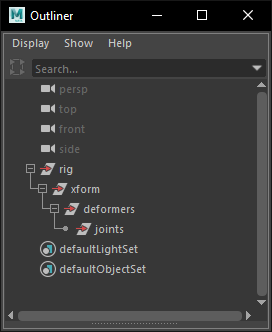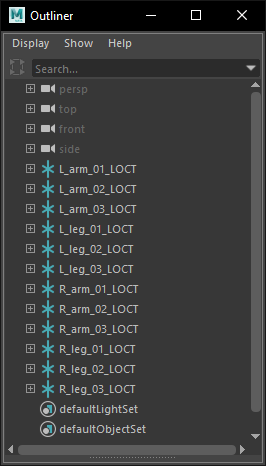Working with Nodes#
Constructors#
Aside from the usual Maya commands, Paya lets you create nodes using a standard set of constructor methods. These offer a range of useful options and help to unify disparate initialization procedures for complex systems like deformers.
Constructors must be called on node classes rather than instances. Node classes can be accessed via a nodes
attribute on paya.runtime when patching is in effect. Here’s an example of the basic
createNode() constructor, available on every node class:
import paya.runtime as r
with r:
transform = r.nodes.Transform.createNode()
# Result: transform1
More and more Paya classes also implement a higher-level create() method. On Transform,
this includes, amongst other things, a dagPath/dp option to create, insert or retrieve nested groups:
with r:
dfrmGroup = r.nodes.Transform.create(dagPath='|rig|xform|deformers') # absolute
jointsGroup = r.nodes.Transform.create(dagPath='deformers|joints') # relative / best match

Deformers are a priority target for create(). So far, the method has been implemented on
BlendShape, Cluster, CurveWarp
and SkinCluster, with more to come.
Node Names#
Explicit Naming#
Paya methods that generate nodes (i.e. constructors, or methods that call them) typically accept a Maya-style name/n keyword argument:
import paya.runtime as r
with r:
r.nodes.Transform.createNode(n='L_eyeball')
# Result: L_eyeball
When this argument is unavailable, or ignored, the name is generated contextually. By default, this is just the node type with a number suffix:
import paya.runtime as r
with r:
r.nodes.Transform.createNode()
# Result: transform1
But this isn’t the only option.
Implicit Naming#
Default node names can be shaped using Paya’s Name context manager. This accepts any number of
string or integer positional arguments and joins them with underscores into a prefix. It also includes options to
control number padding and studio-style type suffixing.
Here’s a variant of our original example, using Name rather than the name/n argument:
import paya.runtime as r
with r:
with r.Name('L', 'eyeball'):
r.nodes.Transform.createNode()
# Result: L_eyeball_XFRM
Name blocks can be nested across functions calls to accumulate prefixes in logical hierarchies.
This often eliminates the need to pass around name or prefix arguments altogether:
import paya.runtime as r
def buildLimbLocators():
for i in range(1, 4):
with r.Name(i, padding=2):
r.nodes.Locator.createNode()
with r:
for side in 'LR':
for limb in ('arm', 'leg'):
with r.Name(side, limb):
buildLimbLocators()

In the above example, Name has automatically applied studio-style type suffixes (i.e.
XFRM for transforms and LOCT for locators). These can be suppressed per-block using suffix=False. Defaults for
the suffix and padding arguments are read from paya/config.json on startup.
Customizing Type Suffixes#
Paya’s type suffixes have been parsed from the
‘tags’ in Maya’s Node Index. They
are mapped to node types, and loaded from paya/lib/suffixes.json into a suffixes dictionary inside
paya.lib.suffixes on startup.
To edit them, import paya.lib.suffixes and do one of the following:
Edit
suffixes.jsonand callpaya.lib.suffixes.load()to update the dictionary without restarting Maya.Edit the dictionary (
paya.lib.suffixes.suffixes) instead, and callpaya.lib.suffixes.dump()to update the file.Start a new scene, edit some node names interactively to indicate your preferred suffixes and call
paya.lib.suffixes.learnFromScene()followed bypaya.lib.suffixes.dump().